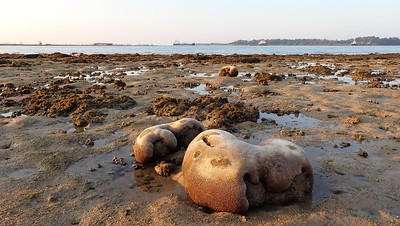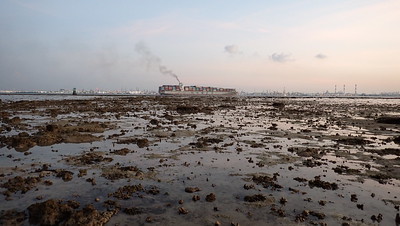Today, a small team surveys with sea anemone experts! Arriving a dawn to enjoy a spectacular sunrise. The seagrasses are doing still doing well, and we find some sea anemones. Marcus saw a Burrowing giant clam!
What a relief that we could find sea anemones on the shore. Haddon's carpet anemone, Giant carpet anemones (alas, no 'Nemos'), Wiggly reef star anemone, Frilly anemones, Fire anemone, Peachia anemone. It was great to see the usual animals. On the sand bar, lots of Oval moon snails and their sand collars. Nearby, still some Common sea stars. There were also lots of swimming crabs.
Although I couldn't find the Giant clam near our landing point, Marcus saw a Burrowing giant clam about the length of his index finger.
 |
| Photo by Marcus Ng. |
Most of the corals here are boulder-shaped. I saw a few small clusters of Branching montipora coral, perhaps the beginning of a field of them? Richard saw large clusters of leathery soft corals.
Seagrasses seem to be doing well still. There were sprinkles of seagrass on almost the entire reef flat from the reef edge to the centre. On the sand bars and among the more reefy parts. I sense it is somewhat similar to our survey in Jan 2022, which was better than Aug 2021. In some large parts, the seagrasses were growing more densely. The most common were Spoon seagrass (mostly small leaves) and Sickle seagrass. I saw many clumps of Tape seagrass, some had longish leaves (about 30cm) and some were still cropped short.
Today, I didn't see any dugong feeding trails in the meadows of Spoon seagrass in the sandy centre of the reef flat near the arrival point. On our last survey in Jan 22, we saw only a few possible trails. We saw clearer trails in Aug 2021. We saw some on our last survey on Jul 2020. We didn't see any on our last survey in May 2019. We saw many trails in Dec 2018. Also in Aug 2016. The first time we noted them was in May 2012.
Near the landing point, there was signs of a small boat strike. With corals churned up and holes left behind. We didn't see any active fish traps. And it was nice to see a few sea turtles come up for air while we waited on the boat.
What is the fate of Terumbu Pempang Laut?
Pulau Hantu and all the terumbus west of it are slated for massive reclamation outlined recently in the Long-Term Plan Review. Singapore's submerged reefs are often out of sight under the high tide and thus forgotten.
The Singapore Blue Plan 2018
Pulau Semakau and nearby islands and submerged reefs have been recommended by the Singapore Blue Plan 2018 for Immediate Conservation Priority. The Blue Plan recommends the intertidal and subtidal marine areas of Pulau Semakau and adjacent Pulau Hantu, and Pulau Jong to be designated Marine Reserve.
The Blue Plan highlights that Pulau Semakau and its associated patch reefs comprise many ecosystems: coral reefs, mangrove areas, intertidal sandflats, seagrass meadows, and coral reefs. The subtidal area of Pulau Jong is larger than the terrestrial area. Pulau Hantu is a popular dive site has seen increasing interest in the past decade due to biodiversity awareness. If protection is accorded to these three islands, zonation plans for use can be implemented to manage tourism and human impacts.
DOWNLOAD the Plan, SUPPORT the Plan! More on the Singapore Blue Plan 2018 site.
Photos by others on this survey
Richard Kuah
Marcus Ng









